Honestly, there’s no need to stick with just one metal finish throughout your home anymore. Mixing metals can really bring depth, interest, and a bit of sophistication to any room—if you do it with intention.
Remember to repin your favorite images!
If you want your mixed metals to look cohesive, try to limit yourself to two or three different finishes in each room. Otherwise, things can get a little wild.
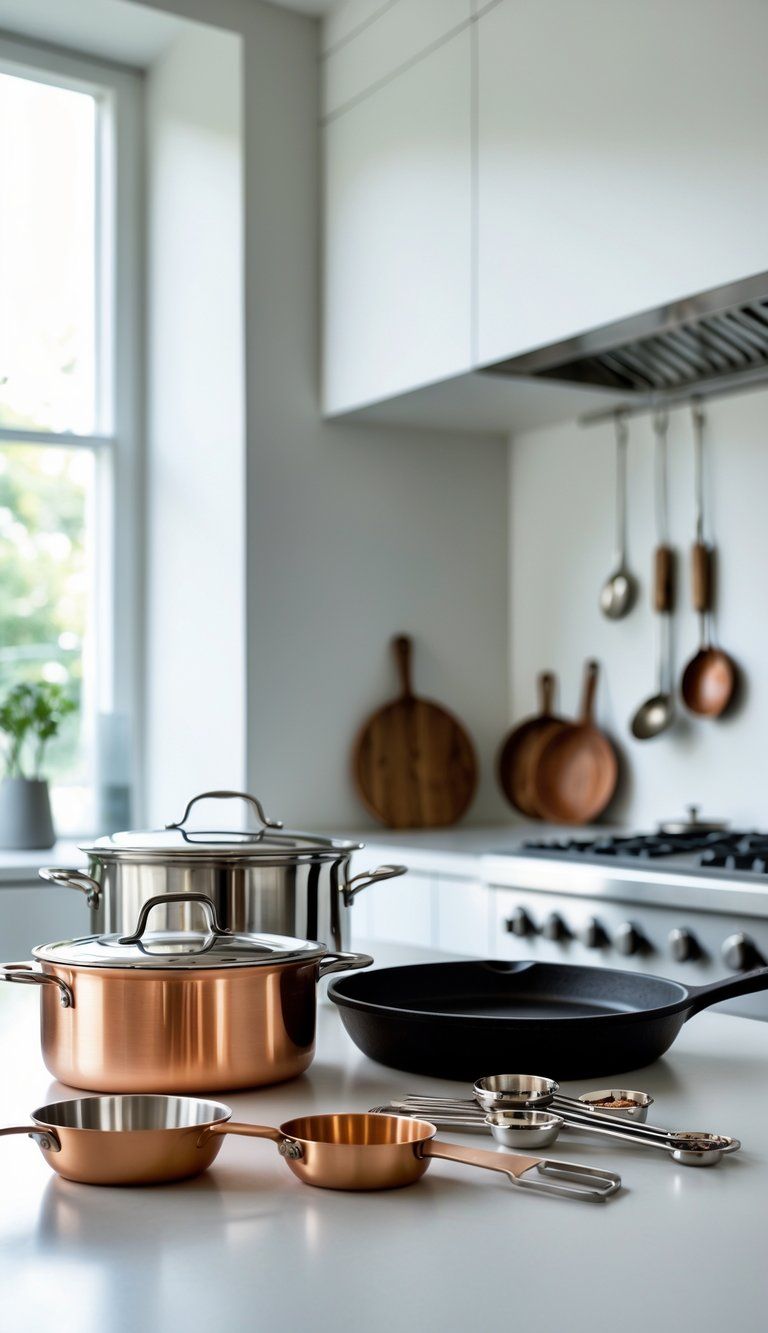
Think of mixing metals as starting a conversation between all the elements in your space. When you put brushed brass cabinet hardware next to stainless steel appliances, you add visual texture and make the kitchen feel a lot more dynamic.
Just be careful not to mix metals that are too close in color but have different undertones—chrome and satin nickel can weirdly clash if you put them together.
Let one metal take the lead as your dominant finish, and let the others support. That way, you guide the eye around the room and avoid a space that feels random or thrown together.
For example, if you have stainless steel appliances and a faucet, you could add brass cabinet hardware and repeat that brass in a light fixture for some balance.
The Fundamentals of Mixing Metals
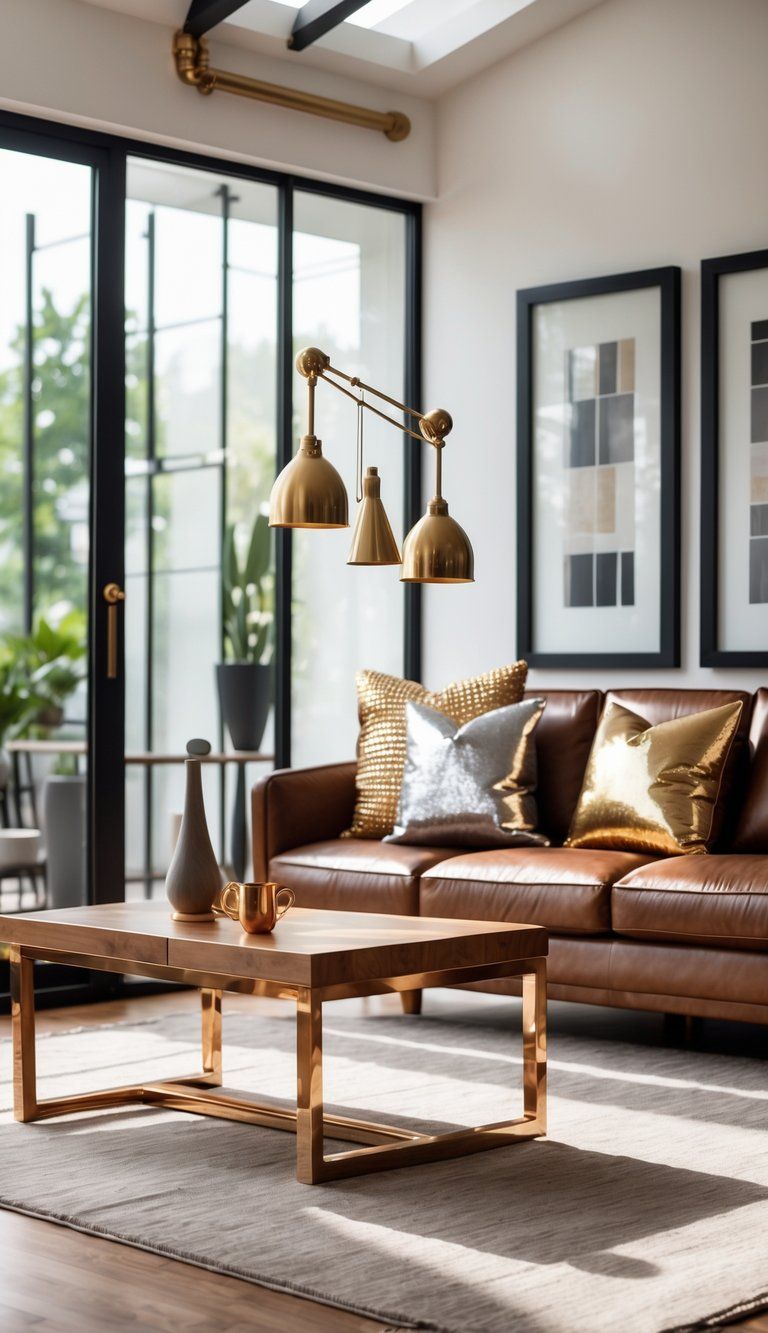
When you understand how to combine metal finishes in your home, you create spaces with way more character and depth. It really comes down to knowing which metals vibe together and how to spread them out.
Why Mix Metals in Home Decor
Mixing metals brings dimension to your space. If you use just one metal everywhere, things can start to feel a bit flat.
Different finishes give your eye something to bounce around on. This approach works especially well in kitchens and bathrooms, where hardware, fixtures, and appliances naturally show off a mix of metals.
When you put warm metals (brass, copper, gold) with cool ones (silver, chrome, nickel), you get a nice, sophisticated balance. It’s a bit like accessorizing an outfit—the right mix just elevates everything.
Matching every single thing isn’t necessary. Actually, intentional variety tends to look more curated and less like you bought the whole showroom.
Benefits of a Mixed-Metal Look
A well-mixed metal space looks like it came together over time, not just bought in one trip. That gives your home a timeless feel.
Mixed metals add visual texture and depth. The way different finishes reflect light keeps things interesting.
A few perks:
- You get a custom, designer-like look
- It’s easier to update decor without starting over
- You can use meaningful pieces, no matter the finish
- The space feels less sterile and more lived-in
When you mix metals intentionally, your home gets a little more personality. It shows some confidence, too, and makes the space feel truly yours.
Common Myths About Mixing Metals
Myth #1: You should never mix warm and cool metals.
Truth: When you combine warm (brass, gold) and cool (silver, chrome) metals the right way, you actually create a great contrast.
Myth #2: All fixtures in a room must match.
Truth: Mixing up your fixtures adds character. Just spread out similar finishes instead of clumping them together.
Myth #3: You need to use equal amounts of each metal.
Truth: Designers often use the 60/30/10 rule—60% dominant metal, 30% secondary, and 10% accent.
Don’t let so-called “rules” box you in. What matters most is that your mix looks purposeful, not accidental.
Understanding Metal Finishes and Undertones
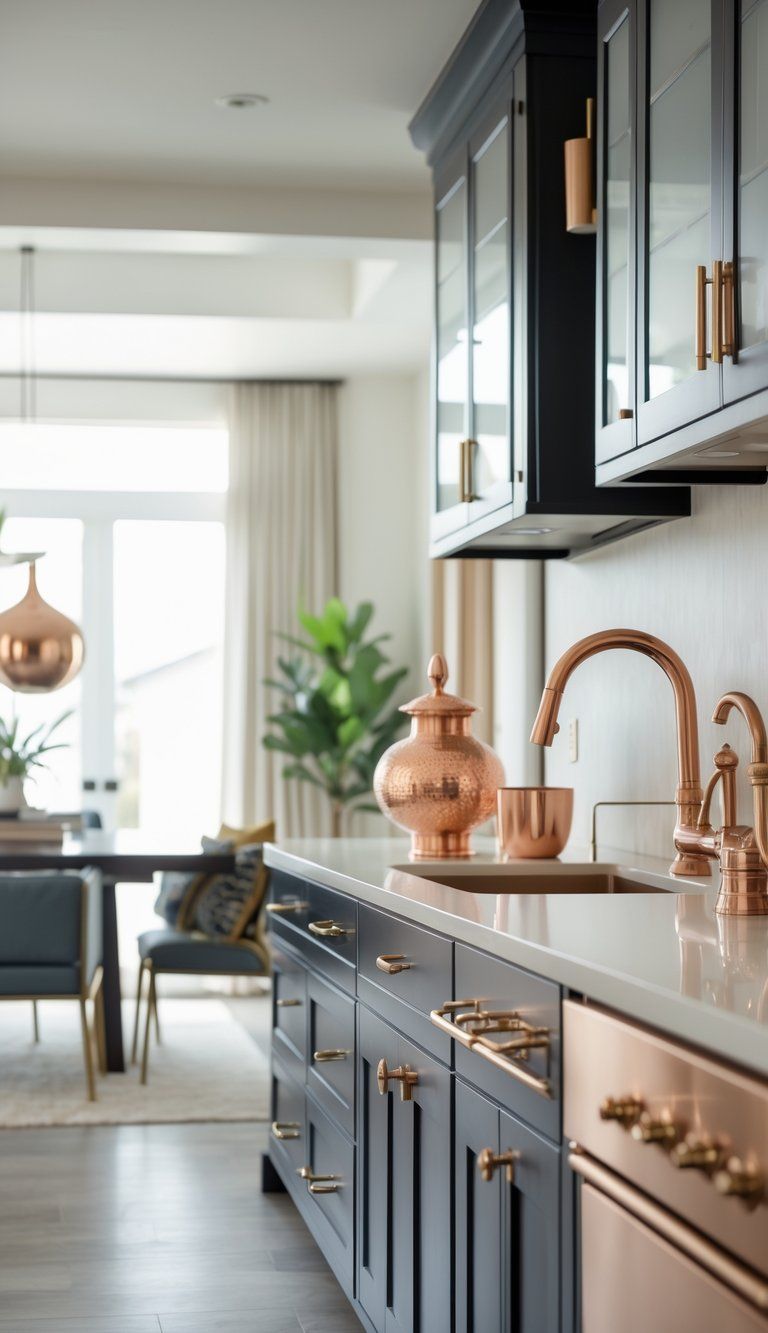
Metal finishes bring out character and depth in your home through their colors, textures, and how they play with light. The right mix can take a flat design and make it layered and interesting.
Overview of Metal Finishes
You’ll see finishes like brushed nickel, polished brass, antique brass, chrome, copper, and matte black in most homes. Each one brings something unique.
Some popular finishes:
- Brushed/Satin: Subtle sheen, hides fingerprints
- Polished: Super reflective, almost mirror-like
- Antiqued/Oil-Rubbed: Darker areas, more depth
- Matte: No shine, modern, and understated
Some finishes are tougher than others. Brushed finishes usually hide wear better than polished ones, so they’re practical for things like door handles and faucets.
Warm Versus Cool Undertones
Metal finishes usually fall into either warm or cool undertones. This bit is pretty important if you want your metals to play nicely together.
Warm Undertones:
- Brass
- Gold
- Copper
- Bronze
- Rose gold
Cool Undertones:
- Chrome
- Nickel
- Silver
- Stainless steel
- Aluminum
Mixing metals from the same color family can backfire. Chrome and satin nickel, for instance, look similar but have different undertones, and they don’t always work side by side.
Pick one dominant tone—warm or cool—and use the other as an accent. That way, you create contrast that looks intentional.
Impact of Texture and Sheen
Texture and sheen change how metals look and feel in your space. These details decide how light hits each surface.
Texture options:
- High polish (super shiny)
- Brushed (soft, linear texture)
- Hammered (dimpled look)
- Aged/distressed (a bit rougher)
The same metal can look totally different depending on its finish. Polished brass is bold, while brushed brass is much softer.
Mixing sheens keeps things interesting. Try matte black hardware with polished nickel faucets, or hammered copper pendants with satin brass pulls. You get depth just from how the light bounces around.
Lighting really changes how metals look, too. Sunlight shows true colors, while artificial light can shift undertones.
Choosing a Dominant Metal and Accent Metals
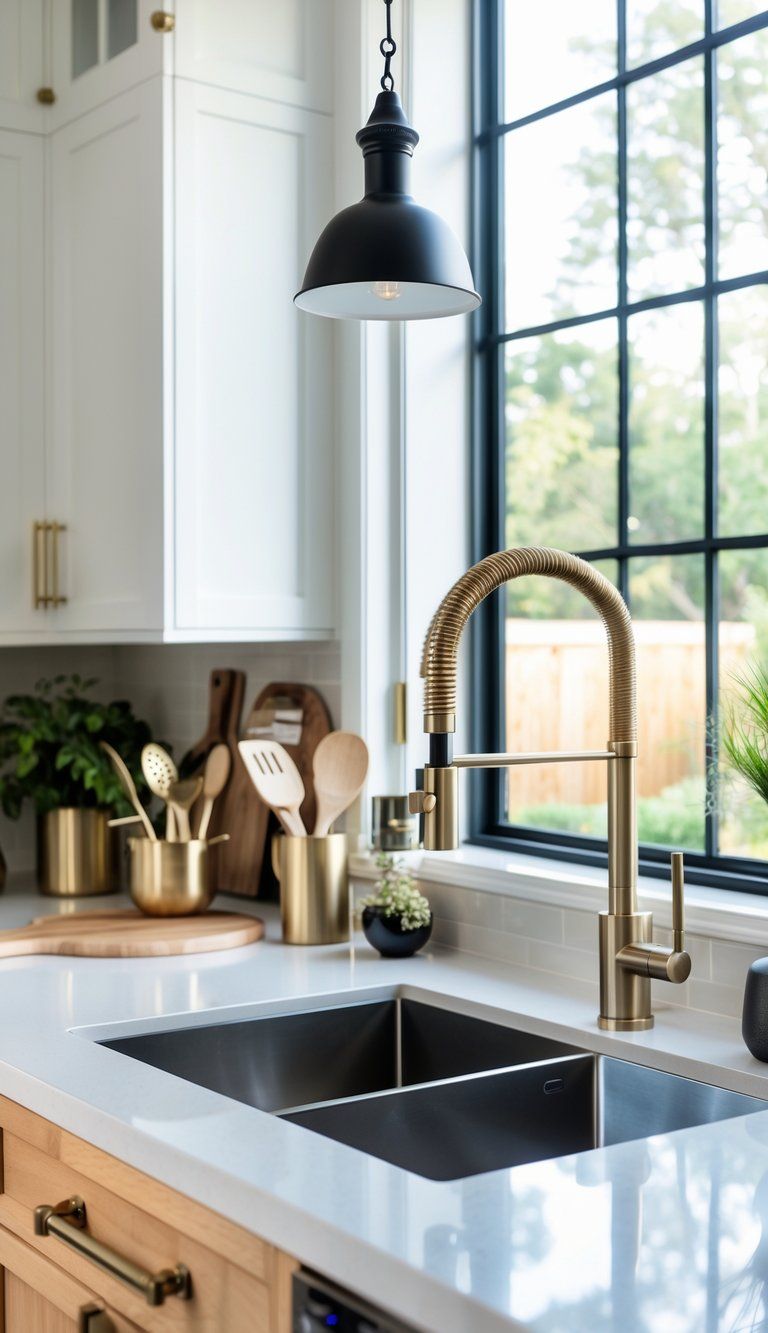
If you want your metals to mix well, you need a clear hierarchy. Pick one dominant metal that shows up the most, then add one or two accent metals for extra interest.
How to Select a Primary Finish
Check out the fixtures and hardware you already have. Which metals do you see? That can help you settle on your dominant metal.
Let’s say your kitchen appliances are stainless steel—silver tones might make sense as your main finish.
Use the 60-30-10 rule: your dominant metal should cover about 60-75% of the finishes in the room. That keeps things grounded.
Think about your home’s style, too. Traditional spaces often look great with brass or bronze, while modern homes lean toward chrome or stainless.
Some common choices for dominant metals:
- Brushed nickel
- Stainless steel
- Oil-rubbed bronze
- Brass
- Matte black
Balancing Accent and Secondary Metals
Once you know your dominant metal, pick one or two accent metals that work well with it. Too many different finishes will make things feel messy.
Pay attention to temperature. Warm metals (brass, gold, copper) and cool metals (chrome, nickel, silver) often look great together, especially when you use one as the main and the other as a pop.
Use your secondary metal for about 30% of the metal elements—think light fixtures, cabinet hardware, or little decor pieces.
Accent metals should be more subtle—about 10% of your total. Maybe that’s picture frames, small accessories, or a unique hardware piece.
A quick tip: Keep finishes consistent for certain categories. For example, all door handles could match your dominant metal, while light fixtures show off your accent.
Rules to Follow When Mixing Metals
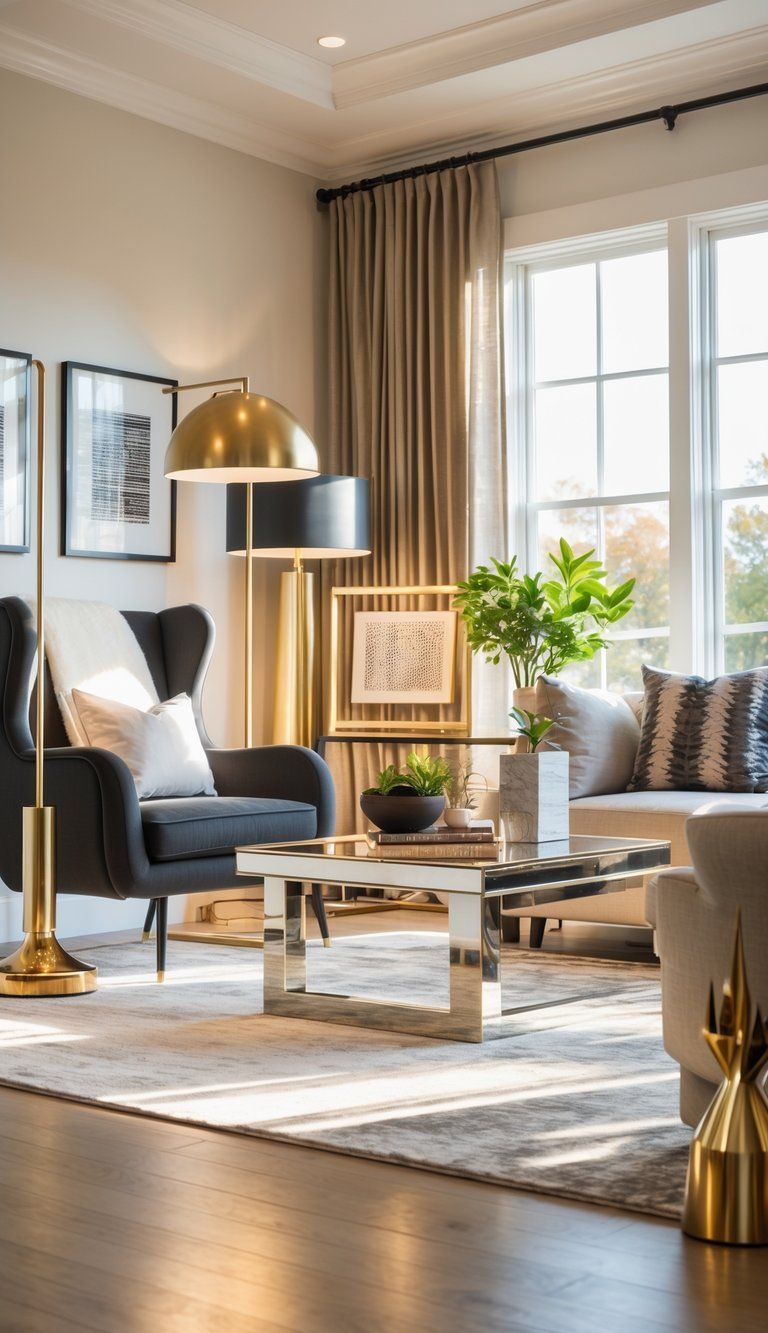
If you mix metals thoughtfully, you’ll get depth and visual interest. A few simple guidelines can help your space feel put-together instead of random.
Limit Your Metal Choices
Stick with no more than three different metal finishes in a single room. Too many, and things start to look disorganized.
Choose one dominant metal for about 60-70% of your metal elements.
For example, in a kitchen, you might pick:
- Brushed nickel for faucets and cabinet hardware (your main metal)
- Matte black for light fixtures
- Brass for a few accents
This three-metal approach gives you balance without losing interest. Most designers suggest making your largest pieces (like appliances) your dominant metal.
Let each metal have a reason for being there. Don’t just toss in a fourth finish because you like how it looks.
Coordinate With Your Color Palette
Your metals should work with your room’s colors. Warm metals (brass, copper, gold) look amazing with warm walls—think beige, cream, terracotta.
Cool metals (chrome, nickel, silver) make cool color schemes—blues, grays, crisp whites—feel complete.
Try these combos:
- Brass/Gold: Looks good with green, blue, cream, white
- Chrome/Silver: Works with gray, white, blue, purple
- Copper: Pops with terracotta, warm neutrals, navy
- Black: Honestly, it goes with anything
Let your metals feel like part of the color story, not in competition with it. Step back and look at the whole space before you choose finishes.
Repeat Finishes for Cohesion
Repeating your metal finishes makes your choices look intentional. If you use a metal, try to bring it in at least twice in the room.
In a bathroom, you might:
- Use brushed nickel for the faucet and towel bars
- Add brass for cabinet pulls and the mirror frame
- Bring in matte black with the light fixtures and shower hardware
Repeating finishes ties everything together. If you only use a metal once, it can look out of place.
Spread your metals out instead of clustering them all in one area.
Mix Warm and Cool Tones Thoughtfully
Warm metals (brass, gold, copper) and cool metals (silver, chrome, nickel) can look fantastic together if you balance them. Use one as your main finish, then sprinkle in the other as an accent.
Don’t mix metals that are too similar in color but have different finishes—chrome and nickel side by side can look off.
Black metal acts as a neutral and can bridge warm and cool tones. It’s a handy go-between.
Common Rules You Can Break
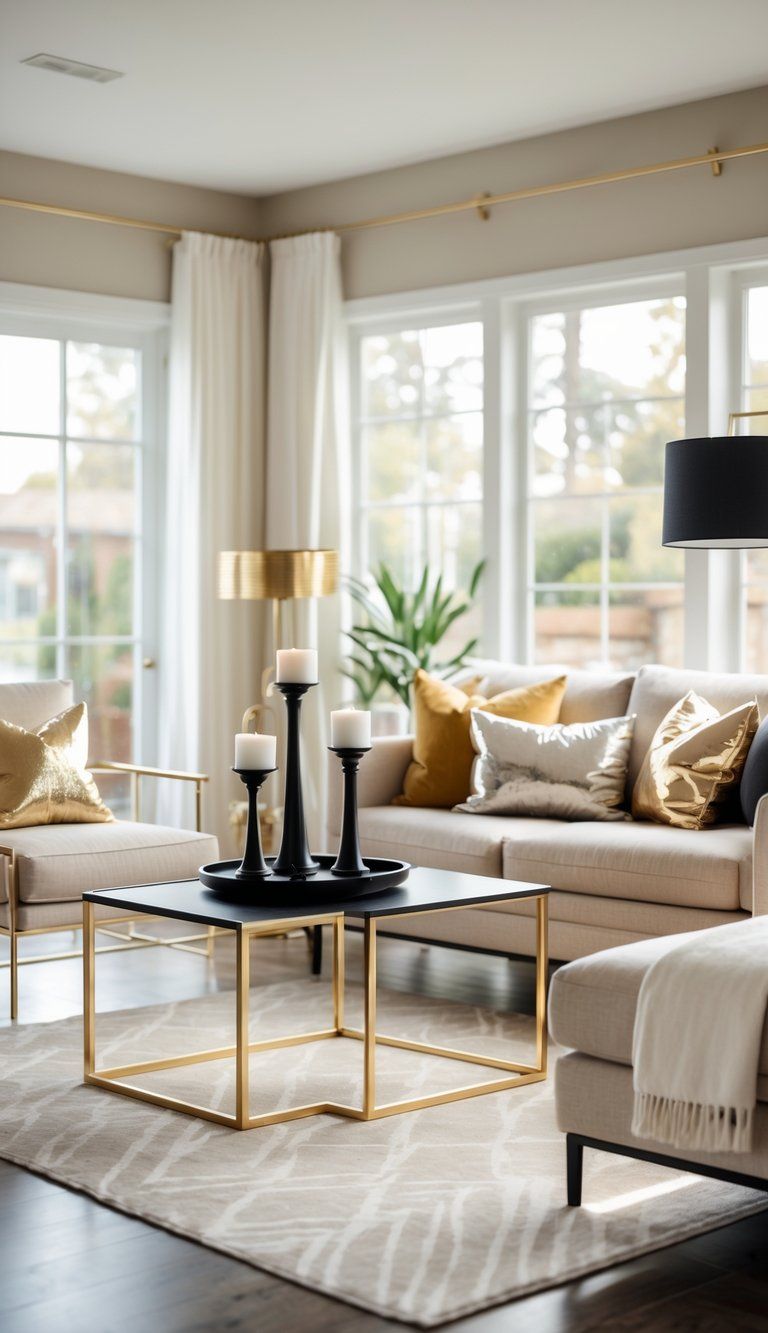
Some guidelines make mixing metals easier, but honestly, a few rules are meant to be broken. At the end of the day, good design is about what feels right in your space.
Embracing Unexpected Combinations
Forget the old “stick to two metals” rule. You can absolutely show off three or more metal finishes at home if you do it thoughtfully.
Repetition is key. Say you’ve got stainless steel appliances and brass cabinet pulls—why not toss in copper pendant lights for an extra layer of interest?
Try mixing things up with brushed gold and chrome. That kind of unexpected pairing brings tension and makes a space feel more curated, less like you just matched everything from a catalog.
If you want balance, repeat each metal at least twice in the room. That way, you create rhythm and avoid a random, thrown-together vibe.
Bold choices really give a space personality. A vintage brass chandelier can totally work with modern matte black sconces, especially if you keep the shapes similar.
Mixing Modern and Traditional Finishes
Traditional decor doesn’t have to mean traditional metals. You can break away from period-specific expectations by mixing timeless pieces with modern finishes.
Take an antique credenza with its original brass hardware—pair it with sleek chrome lamps. Suddenly, you’ve got a visual conversation going between old and new.
Don’t stress about matching metals to your decor style. Even a Victorian-inspired room can rock matte black fixtures for dramatic contrast against all those ornate details.
Try mixing wrought iron (which feels rustic) with polished nickel (super modern) for extra depth. That kind of contradiction adds character, especially in rooms that risk feeling flat.
Back in the day, historical homes had mixed metals out of necessity. So, if anything, your mixed-metal look actually honors authentic traditional decor more than a perfectly matched scheme ever could.
Blending Matte and Polished Metals
Forget the rule about not mixing finishes within the same color family. A matte black faucet can look fantastic with glossy black cabinet hardware, especially when they share the same color.
Different sheens give you subtle texture variations and a touch of sophistication. Try polished finishes on statement pieces like light fixtures, and stick with matte for things you touch a lot, like door handles.
Some combos that work:
- Brushed nickel faucet + polished chrome mirror frame
- Matte black cabinet pulls + glossy black light fixtures
- Satin brass doorknobs + high-shine brass picture frames
Light hits each metal differently, so you’ll notice the look shifts as natural light changes throughout the day.
If you care about fingerprints, matte finishes hide them better than polished ones. That makes matte a smart choice for high-traffic spots.
Mixing Metals by Room
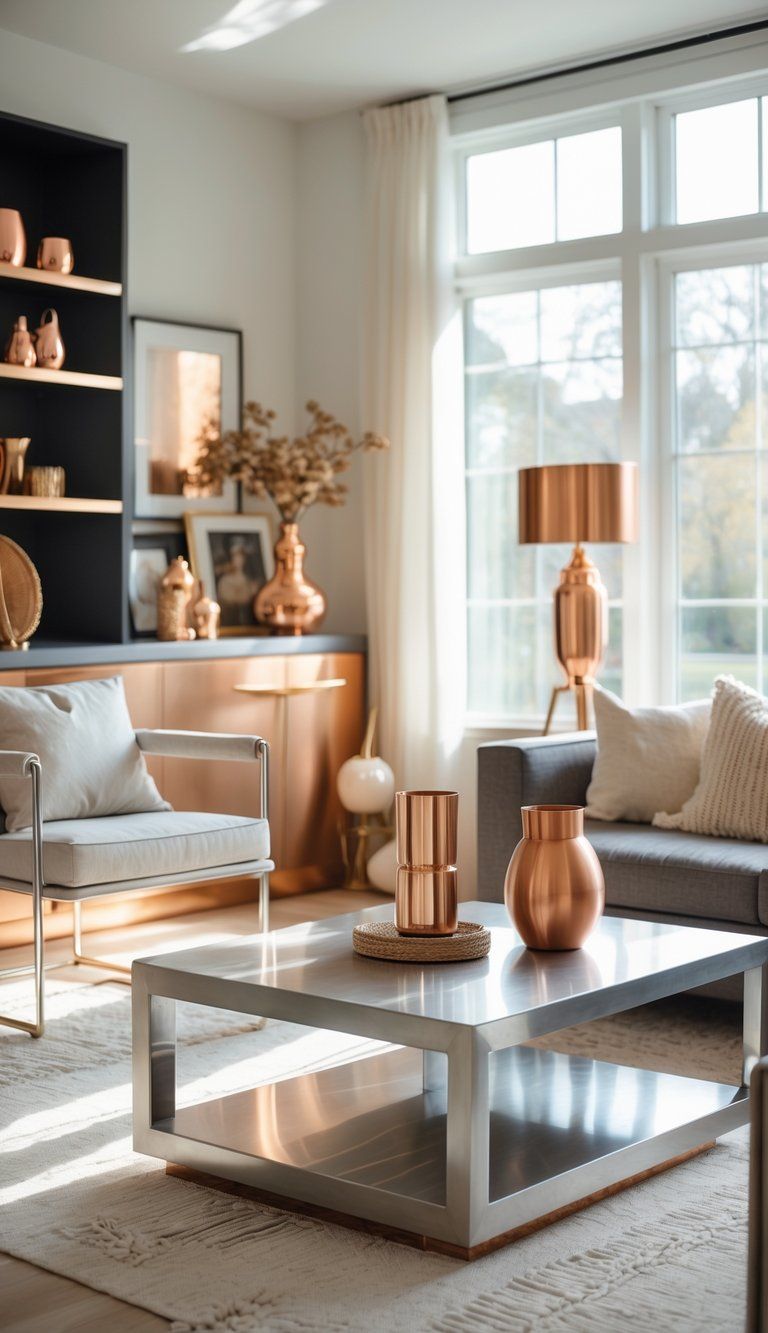
Every room in your home gives you a fresh chance to play with mixed metals. Each space has its own function and vibe, so let that guide your choices.
Kitchen Hardware and Fixtures
The kitchen is probably where you’ll mix metals most naturally. Start with the faucet as your anchor, then build around it.
Got a brass faucet? Try stainless steel appliances and matte black cabinet hardware for some contrast.
For cabinets, here are a few combos:
- Brass knobs with black hinges
- Copper pulls with bronze hinges
- Matte black handles with chrome accents
No need to match your sink hardware to your cabinet hardware. A farmhouse sink with a gold faucet can sit right next to black drawer pulls and look great.
When picking appliances, it’s usually best to stick to one metal finish. That grounds the space, while other accents add the fun. Stainless steel appliances tend to play well with just about anything.
Light fixtures let you bring in another metal. A brass pendant can warm up a kitchen with silver hardware.
Bathroom Plumbing Fixtures
Bathrooms have more plumbing fixtures than most rooms, so you get lots of chances to mix metals. Your faucet, shower head, and towel bars set your metal foundation.
Pick a primary finish for the big stuff. Brushed nickel faucets and matching shower hardware keep things cohesive. Then, toss in contrast with a different metal on mirror frames or lighting.
Try mixing:
- Chrome plumbing with brass lighting
- Matte black faucets with gold mirror frames
- Bronze fixtures with silver accent pieces
For hardware, these pairings work well:
| Primary Metal | Complementary Metal |
|---|---|
| Chrome | Brass or Black |
| Black | Gold or Nickel |
| Brass | Bronze or Black |
Smaller accessories—think soap dishes or toothbrush holders—can add a third metal without making things feel chaotic.
Living and Dining Room Decor
Living and dining areas give you the most freedom to mix metals through furniture, lighting, and decor. With no fixed plumbing, you can get creative.
In living rooms, look at metal finishes on:
- Coffee table bases
- Side table frames
- Floor lamp stands
- Picture frames
- Decorative bowls
A brass coffee table looks right at home with silver picture frames and black sconces. Keep big furniture in one metal family, then layer in smaller accents.
Dining rooms love a statement light fixture. A gold chandelier can steal the show, with silver candlesticks on the table for backup.
Wall sconces offer both style and function. Try matte black sconces with shiny brass table lamps for a contrast that pops.
Bedroom Accents and Lighting
Bedrooms usually call for a more restrained hand with metal mixing. Sticking to two complementary metals keeps things calm and inviting.
Your bed frame often sets the tone. A brass bed frame pairs nicely with:
- Bronze wall sconces
- Antique gold picture frames
- Copper bedside lamps
Lighting matters here. You might choose:
- A ceiling fixture in your main metal
- Bedside lamps in a complementary finish
- Reading sconces in either
Drawer pulls and handles are another way to sneak in a different metal. Black hardware on a dresser works with brass lamps nearby.
Mirrors, frames, and trays let you experiment with mixed metals without making any permanent changes.
Popular Metal Pairings and Finishes
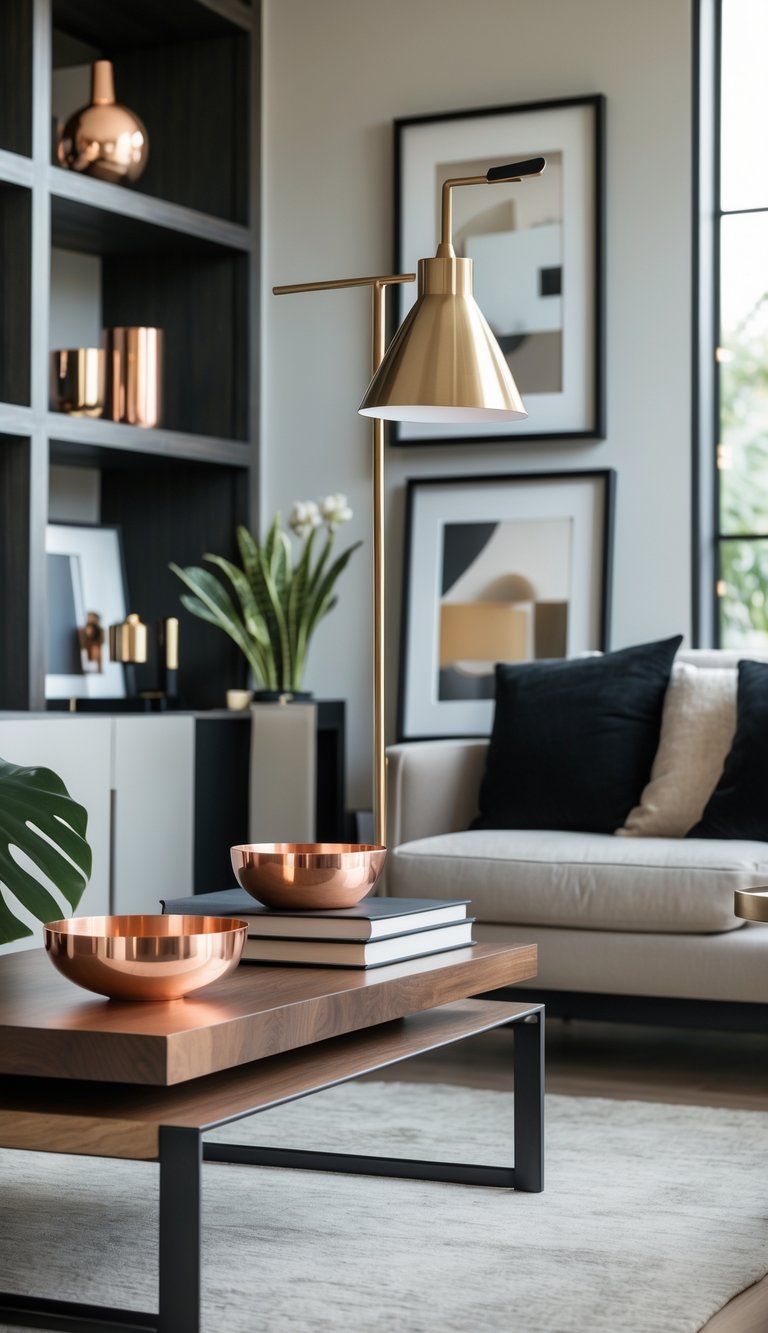
Some metal combos just work, especially when you pair them with intention. Mixing finishes adds depth and keeps your space from feeling flat.
Brass and Bronze
Brass and bronze make a warm, classic pair. They both have golden undertones, so they naturally complement each other.
Brass is brighter and brings a golden glow to the room. Bronze is a little darker, with reddish-brown undertones for subtle contrast.
Use brass for statement pieces—lighting or cabinet hardware. Bronze feels right for bigger items like bathroom faucets or decor.
Mix polished brass with oil-rubbed bronze if you want maximum contrast but want to stay in the warm metal family.
Chrome and Black
Chrome and black metal bring a bold, modern vibe. The contrast is strong, but the combo stays neutral enough to fit any color scheme.
Chrome brings:
- Shiny, reflective surfaces
- Cool undertones
- A crisp, modern look
Black metal offers:
- Matte or semi-gloss finish
- Dramatic anchor points
- Clean lines and definition
Chrome works well for anything that catches the light—faucets, mirror frames, lighting. Black is great for furniture frames, pulls, and fixtures that need to stand out.
This pairing really shines in kitchens and bathrooms, where contrast can highlight key features without making things feel busy.
Stainless Steel and Polished Nickel
Stainless steel and polished nickel are a cool-toned match that bridges industrial and refined styles. Both look silvery, but the differences keep things interesting.
Stainless steel feels a little matte and practical—think appliances, sinks, and handles. It’s tough and shrugs off water spots, so it’s great for busy areas.
Polished nickel has a warmer, almost golden undertone. It feels more luxe and works for decorative stuff like lighting, mirrors, or statement hardware.
Try stainless steel for big surfaces and polished nickel for accents. You’ll get depth without clashing.
Copper and Antique Brass
Copper and antique brass bring rich, warm energy to a space. They both have reddish-brown undertones but enough difference to keep things interesting.
Copper pops with a pinkish-orange glow and develops a patina over time. Use it for:
- Range hoods
- Decorative bowls
- Pendant lights
- Accent tables
Antique brass has a softer, aged gold look. It works for:
- Cabinet pulls and knobs
- Picture frames
- Lamps and sconces
- Bathroom fixtures
This combo suits kitchens, living rooms, and bathrooms. The warmth feels inviting and lived-in. If you go with this pairing, it’s usually best to keep other metals to a minimum.
Lighting and Hardware: Key Metal Elements
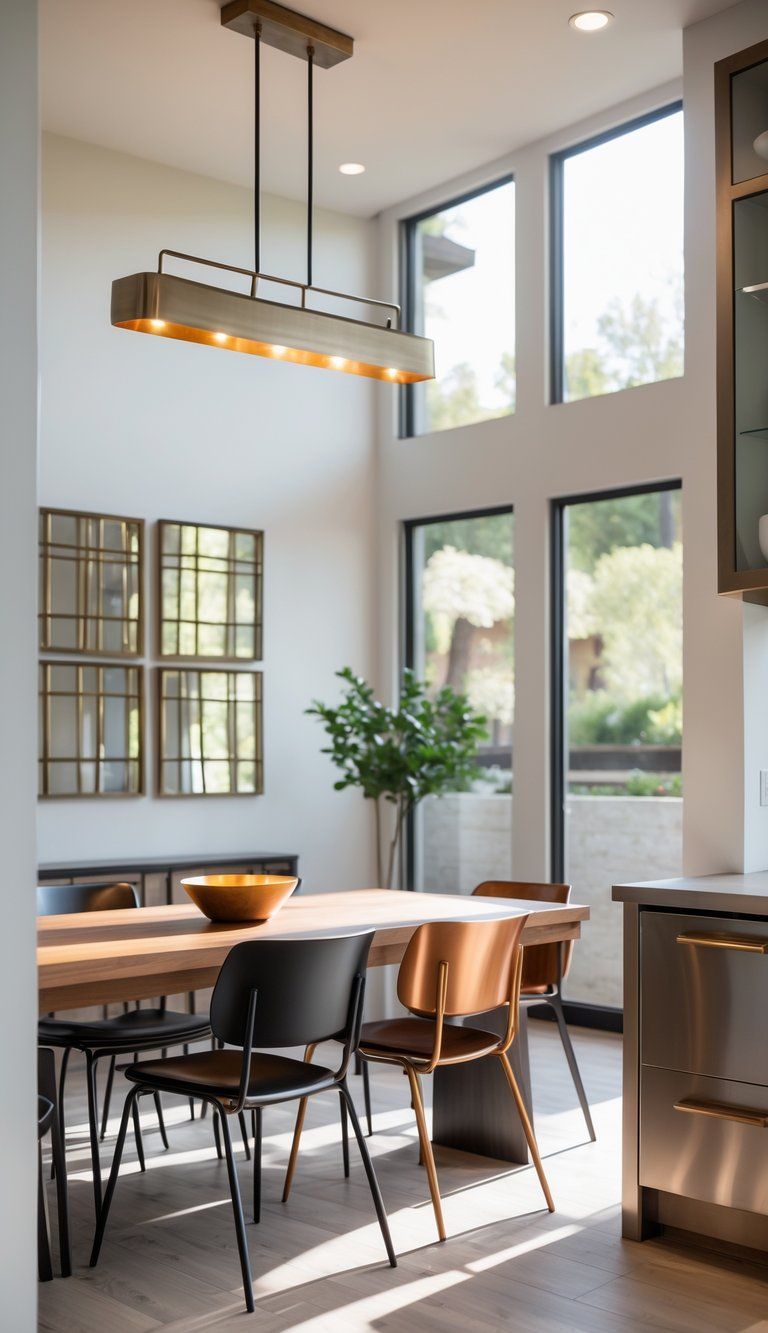
Light fixtures and hardware are basically your home’s jewelry. They can either pull a room together or add interest by mixing metals in clever ways.
Choosing Metal for Light Fixtures
Light fixtures are a great spot to make a statement with metals. If you go for a brass fixture, think about how it’ll play with other metals in the room.
Brass brings warmth and pairs well with matte black or chrome accents.
Room color temperature matters too. Warm metals like brass or copper fit warm-toned rooms, while chrome and nickel look right in cooler spaces.
The size of your fixture makes a difference. A big chandelier in a bold finish grabs attention, while smaller fixtures can blend in and support your overall metal scheme.
Don’t be afraid to mix finishes within the same family. A brass pendant can hang out with chrome sconces as long as the styles feel related.
Coordinating Cabinet and Drawer Hardware
Cabinet hardware and drawer pulls might be small, but they have a big impact. These pieces should work with your faucets and light fixtures, but they don’t have to match exactly.
Pick one dominant metal for hardware, then add a secondary metal as an accent. For example, if your kitchen faucet is brushed nickel, match the pulls, then sprinkle in a few brass knobs for interest.
Texture is just as important as color. A hammered copper handle feels totally different from a smooth one, even if they’re both copper.
For a pulled-together look, keep each hardware type consistent. Maybe all handles are one finish, and all knobs are another.
Swapping hardware is easy and low-risk, so it’s a fun way to experiment with new metal mixes.
Mixing Metals in Wall Sconces
Wall sconces give you another way to mix metals, especially since you usually install them in pairs or groups. Use them to balance your metal scheme.
Try sconces in a different finish from your main light. If your ceiling light is nickel, brass sconces add warmth and contrast.
Where you put them matters. Sconces near mirrors or art can highlight those features and bring more metallic shine to your walls.
In bathrooms, coordinate sconces with either faucets or towel bars for a little connection. You don’t need to match everything—just make some intentional links.
Mixed-metal sconces look best when they share a design element. Similar shapes or styles help them feel purposeful, not random.
Adding Sophistication and Timelessness with Mixed Metals

Mixing metals adds a layer of sophistication that a single-metal scheme just can’t pull off. When you do it thoughtfully, your space feels curated and timeless—not flat or overly trendy.
Creating Visual Interest
Metal finishes bring depth and dimension to any room. By mixing brass, chrome, and bronze, you create visual texture that draws the eye around.
Think of metal elements like jewelry for your home. You might wear a gold necklace with silver earrings—so why not pair a brass faucet with brushed nickel hardware?
Contrasting metals make great focal points. A copper pendant over a kitchen island with stainless appliances makes both features pop.
Try to use metals at different heights. Wall sconces in one finish, table lamps in another, and floor accents in a third will give you a layered, intentional look.
Achieving an Elegant Look
Pick a dominant metal for your room—let it make up about 60-70% of the metal finishes. This way, you’ll get a base that feels pulled together, not busy.
Choose metals that work well together. Warm metals like gold, brass, and copper just seem to get along. Cool metals—think silver, chrome, nickel—do the same. If you’re feeling adventurous, try mixing one warm with one cool metal for a little edge.
Quality really does beat quantity here. It’s better to invest in well-made metal pieces than to crowd the space with a bunch of cheap finds. A few carefully chosen items in different metals can look way more elegant than a sea of matching stuff.
Remember, metal finishes show up everywhere—on furniture, lighting, and even those little decorative bits. Imagine a brass-based coffee table, a blackened steel lamp, and some silver photo frames. That mix can look surprisingly sophisticated.

